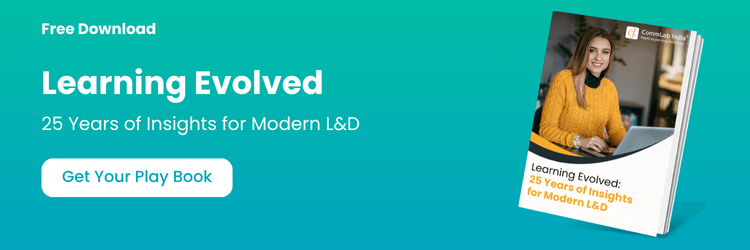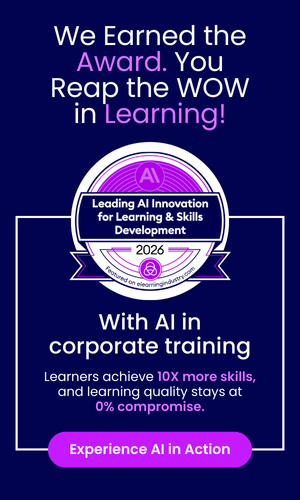In our journey through the evolution of eLearning, we’ve seen how far the field has come, from the early days of digitized content to the strategic integration of learning into business. Stage 3 was all about using eLearning strategically: aligning training with organizational goals and proving its ROI.
But what happens next?
The next leap is when learning stops playing a supporting role and starts driving competitive advantage. This is where organizations move past standalone courses and embrace a learning ecosystem, a dynamic blend of formats, technologies, and cultural practices that makes learning continuous, scalable, and business-critical.
Download Play Book: 25 Years of Insights for L&D Leaders
Table Of Content
- How did the Post-COVID Era Redefine Learning Delivery?
- What Sets a Learning Ecosystem Apart?
- How does Learning Become a Competitive Advantage?
- What Role does AI Play in Modern Learning Ecosystems?
- How a Fintech Rolled Out Global Training in Record Time with AI + Agility
How did the Post-COVID Era Redefine Learning Delivery?
Between 2020 and 2023, the learning landscape underwent its fastest evolution yet. As remote work became the norm and business operations went fully digital, organizations faced an urgent need to reimagine training delivery. Traditional methods couldn’t keep pace with changing skills, shifting roles, and dispersed teams. L&D leaders had to pivot fast — replacing classroom sessions with virtual ones, reworking instructor-led content into digital formats, and ensuring accessibility across devices and time zones.

Companies began adopting agile development models, forming cross-functional teams to design and deploy learning at record speed. Blended learning ecosystems emerged, integrating eLearning, VILT, microlearning, and performance support. What began as a crisis response evolved into a smarter, more sustainable way of learning, marking the rise of interconnected learning ecosystems that continue to shape the future of corporate training.
What is a Learning Ecosystem?
A learning ecosystem is the interconnected environment of people, tools, content, processes, and culture that supports continuous learning and performance across an organization.
Instead of treating training as isolated courses or one-off events, a learning ecosystem integrates learning into the flow of work, making it accessible, personalized, and impactful.
What Sets a Learning Ecosystem Apart?
Unlike earlier stages, where training was delivered in isolation, an ecosystem integrates learning in the flow of work:
- Moving beyond courses to ecosystems of blended formats (VILT, microlearning, job aids)
- Embedding a culture of continuous learning across the organization.
- Leveraging AI in training for speed, personalization, and analytics.
- Shifting from “Does training work?” to “How much faster does training help the business win?”
In 2024, the average number of formal learning hours used per employee was 13.7, down from 17.4 in 2023. This indicates a move toward informal, on-demand, and in-the-flow learning approaches.
Source: ATD
How does Learning Become a Competitive Advantage?
When learning is ecosystem-driven, it fuels performance instead of simply tracking completions. The impact shows up in:
- Agility: Faster content development cycles—weeks, not months.
- Scale: Seamless global delivery across diverse learners.
- Sustainability: Long-term learning habits embedded into daily workflows.
Real Results
A global food safety company transformed its 18-week classroom leadership training program into a virtual instructor-led format (VILT) in just 2.5 weeks with CommLab India—ensuring seamless learning continuity during the pandemic while resolving unique virtual training challenges.
What Role does AI Play in Modern Learning Ecosystems?

Today, it’s almost impossible to talk about training without talking about Artificial Intelligence. Just as the internet reshaped access to information, AI is reshaping how learning is designed, delivered, and experienced. It’s no longer a futuristic add-on; it’s the backbone of modern learning ecosystems. It allows L&D teams to:
- Build personalized learning journeys at scale.
- Generate content faster with AI-driven authoring and voiceovers.
- Use predictive analytics to link learning behavior to business performance.
- Automate translations and adaptations for global audiences.
What Gives CommLab India the Edge in AI-Powered Learning?
CommLab India now leads the way in AI-powered corporate training.
- Thousands of courses delivered each year through agile, cross-functional teams.
- AI seamlessly embedded in design, development, and delivery for speed and precision.
- Strategic partnerships with global enterprises to integrate compliance, technical, and sales training into cohesive learning ecosystems.
- Outstanding learner feedback, reflecting engagement, effectiveness, and measurable impact.
Today, CommLab India drives learning transformation across 50+ countries, setting the benchmark for innovation and excellence in digital learning.
1. Blend Formats to Match the Flow of Work
Not every learner needs a full course; sometimes a quick aid works better. Leaders must design with flexibility.
- Manufacturing: Pair immersive simulations for machine handling with mobile job aids on the shop floor. Workers can practice in a safe digital space and reference quick tips during production.
- Finance: Use microlearning bursts for frequent compliance updates. Employees can stay current with evolving regulations without leaving their workflow.
Tip: Audit your training library—identify where a 30-minute course can be broken into 3-minute just-in-time modules.
2. Build a Culture of Reflection and Peer Learning
Learning ecosystems are powered by people. Leaders must encourage continuous dialogue, feedback, and shared learning.
- Pharma: After regulatory or clinical trial training, hold short team debriefs. Scientists can discuss real-world application and flag gaps early.
- IT & Software: Create peer review sessions where developers share insights from code reviews or retrospectives, turning every project into a learning moment.
Tip: Add reflection prompts at the end of modules—questions like “What’s one way you’ll apply this tomorrow?”

Learning Evolved: 25 Years of Insights for Modern L&D Leaders
Get ready to:
- Benchmark your eLearning journey
- Start with what’s working for top enterprise L&D teams
- Explore self-assessments, planners, and other tools
- Much More
3. Measure What Matters—Performance, Not Just Completions
Tracking “courses completed” doesn’t tell you if learning worked. Leaders must connect training to outcomes.
- Manufacturing: Link safety training to reduction in incident rates.
- Finance: Align compliance training programs with audit accuracy improvements.
Tip: Partner with business leaders to define success. Training metrics should map to KPIs already tracked on the business side.
4. Use AI as the Accelerator
Artificial Intelligence is the multiplier that makes ecosystems scalable and adaptive.
- Pharma: AI-driven training translations ensure SOPs and training are rapidly localized across global teams.
- IT & Software: Adaptive learning paths help employees stay ahead of new frameworks or tools based on real-time skill gaps.
Discover how adaptive learning paths create personalized, engaging, and more effective skill-building for every employee.
Tip: Start small. Pilot AI for one high-need area (e.g., compliance in finance or safety in manufacturing) and expand after proving impact.
How a Fintech Rolled Out Global Training in Record Time with AI + Agility
Challenge:
A leading fintech company needed a global awareness program delivered fast, including a quiz board game and three AI-driven eLearning courses.
Solution:
A small team of 3–4 developers built all three 45-minute modules and the game in just two weeks using Articulate Storyline with AI voice-over.
Impact:
The result was 45 minutes of engaging, high-impact training delivered globally, proving that speed and quality can go hand in hand.
The Path Ahead
As we’ve journeyed through the four stages of eLearning evolution, one thing has become clear: every stage has shaped how organizations learn, adapt, and perform. From early digital conversions to immersive, AI-driven ecosystems, the evolution of eLearning reflects more than just technological change; it’s a story of how people and organizations have learned to learn better. Each phase has brought us closer to creating experiences that are faster, smarter, and more human, powered by data, designed with empathy, and driven by continuous innovation.
If you’re ready to take the next step and map your journey into the future of learning, don’t leave it to chance. Download our interactive playbook — your guide to designing learning experiences that transform performance, engage minds, and help your organization thrive in today’s digital-first world.






